|
105. Melitaea didyma (Esper, 1778) / Spotted fritillary / Nymphalidae – Melitaeinae
NL: rode melitea, tweekleurige parelmoervlinder / D: Roter Scheckenfalter / F: damier orangé, melitée orangée
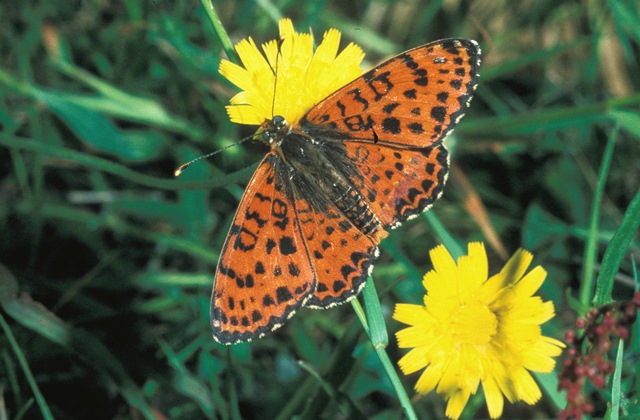 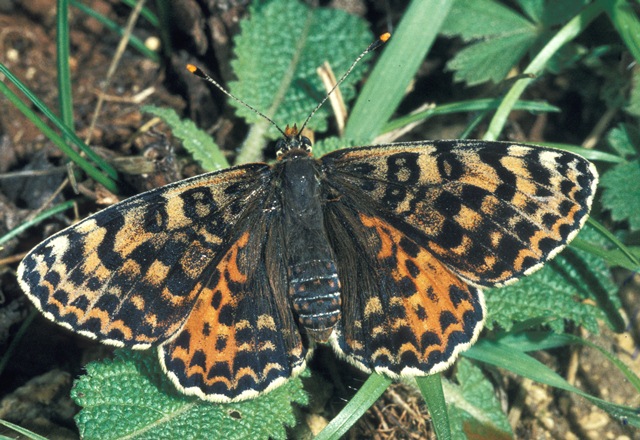 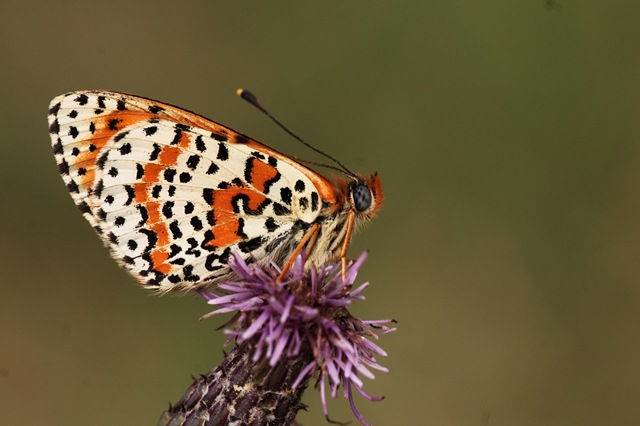
Photographs: Frits Bink, Frits Bink, Jeroen Voogd ©.
Medium-sized, wing length 21 (18-24) mm. The species inhabits dry and warm sites and occurs in the Benelux as a vagrant in the south of Wallonia and is considered to be extinct in Luxemburg. However, in the nearby chalk grassland and heathland in Germany and France it occurs on several sites.
Butterfly is on the wing from early-June until late-August. The species is known from sub-continental and continental climates, amplitude 8 to 16. Required heat sum is 900°d and maximum tolerated 3000°d, corresponding climate windows 26 weeks and full year open.
The species is polymorphic in females and varies from dark brown to red and is then similar to males. It occurs in steppe and semi-desert and has a complex taxonomy.
In some situations it is a good indicator of micro climate as it is on the hill called Katzenkoepfle in the Vosges, where the south-eastern slope is much dryer compared to the surrounding area and the species thrives there.
Ecological characteristics
Behaviour over time
Overwintering: small larva, about 6 mm in length, solitary on an unsheltered wilted inflorescence.
Reproduction: oviposition starts after 5-7- days when the body contains 90 (78-134) eggs, estimated potential production 3.3, times as much.
Larval feeding periods: in summer 25 (21-29) days in period end-July until end-August, in next spring 50 (32-65) days from mid-April until mid-June.
Generations: one in temperate climate, several in succession in Mediterranean area.
Spreading of risk: lengthening and flexibility of diapause.
Life cycle: egg about 8 days; larva 47 weeks; pupa 15 (12-18) days.
Life span of adult: long, 4 weeks.
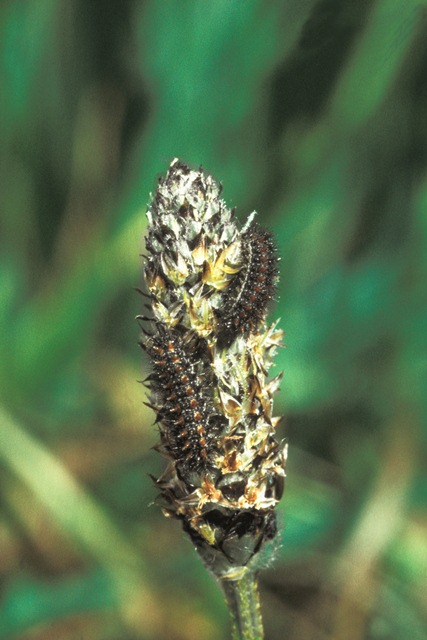 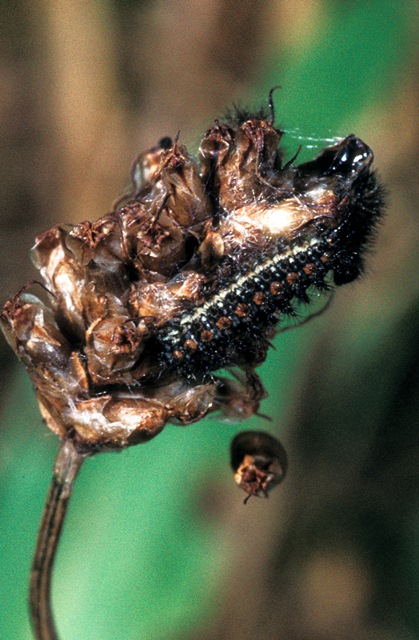 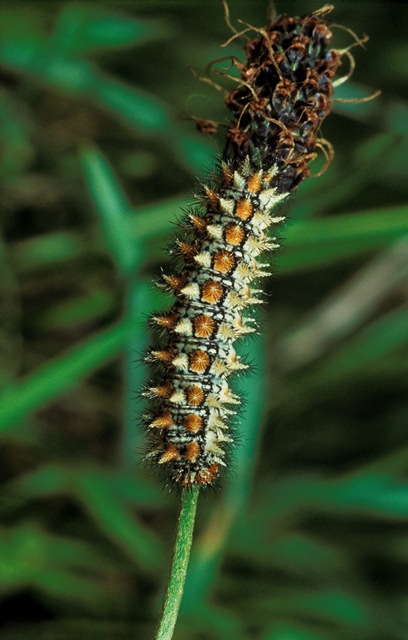
Photographs: Frits Bink ©.
Behaviour in space
From stay-at-home to migrant: stay-at-home, spatial requirement considerable.
Finding a mate: male patrols.
Orientation in the landscape: open field with short vegetation and patterns of short and tall grass.
Oviposition: small batches of 20-60 eggs on the underside of a leaf.
Defence
Threats from other organisms: larva is armoured with stiff bristles.
Threats from the environment: cold and wet weather.
Feeding habits
Adult: nectar, butterfly prefers yellow composites.
Larva: among Melitaeini it is unique in overwintering on prostrate wilted inflorescences and to feed in the early spring on pistils and stamens or very young shoots of plantain.
Larval foodplants
Plant species: Laminaceae, Stachys recta, Plantaginaceae, Plantago lanceolata, P. media, Orobanchaceae, Linaria vulgaris, Melampyrum arvense.
Journal
Rearing experiments:
1. Based on specimens from Katzenkoepfle, 565m, Vosges, France.
27 July 1983: three female captured.
31 July: eggs laid.
7 August: eggs hatched.
5 September: larvae 2 or 3 together on an inflorescence.
25 September: in diapause: about a quarter of the larvae had chosen the old inflorescences of the Plantago lanceolata, the others hid under wilted leaves.
Overwintered outdoors.
8 April 1984: first larva became active.
14 April: larvae active and ate the pistils of the new inflorescence and a few ate young leaves.
23 April: larvae fed on the leaves and ate normally at a temperature of 47°C in full sunshine.
3 May: three larvae in fourth instar.
24 May: two larvae in last instar.
2 June: larvae also ate Veronica chamaedrys.
5 June: biggest larva fully grown, smallest one third instar.
12 June: three pupae.
1 July: three males appeared.
3 July: first female appeared.
11 August: last one emerged.
2. Based on specimens from Nollig Mountain, Lorch, Rhine Valley, Germany:
1 August 1985: some first and second instar larvae collected from Stachys recta.
19 August: larvae 9 mm in length.
6 September: all larvae in diapause in third instar in small groups together under wilted leaves.
Overwintered indoors.
16 April 1986: some larvae on the inflorescence of the Plantago started to eat the pistils.
19 April: larvae gathered together on the places where they overwintered.
30 April: first larva in L4. Inflorescence of Plantago had been eaten completely.
4 May: first larva last instar. Inflorescence of Plantago is grazed again as soon there were some eatable parts.
17 May: ants (Formica rufa) introduced to test how larvae could defend themselves; after five minutes the ants give up their attack because they could not handle the larva because of its covering of bristles.
18 May: first pupa. Larvae had also eaten Veronica chamaedrys, Verbascum and Stachys sylvatica.
24 May: the half of the larvae now pupated.
30 May: first adult appeared.
9 June: male and female appeared.
16 June: last pupa hatched.
Additional data about larvae and host plant at Lorch, Rhine valley, Germany:
27 July 1983: young larvae in clusters of about 10 individuals on Stachys recta.
1 August 1984: larvae first and second instar on Stachys recta.
14 June 1985: larvae fully grown on Stachys recta.
26 August 1985: larvae in moult L3-4 and also in first and second instar which were collected.
6 September 1985: all larvae in diapause, 9 mm in length.
26 May 1986: larvae nearly fully grown on Stachys recta and Melampyrum.
Table 105-1. Results of dissections

Table 105-2. Collection and observation localities
D, Arnstein, 50° 01’ 57”N – 9° 47’ 41”E; 22 July 1984.
D, Lorch, 300m, 50° 02’ 05”N – 7° 47’ 56”E; for dates see above.
F, la Bruyère, 45° 39’ 01”N – 5° 38’ 09”E; 25 August 1984.
F, Katzenkoepfle, 565m, 48° 01’ 54”N – 7° 06’ 04”E; 21 August 1984.
F, Lorraine, Dieue-sur Meuse, 49° 05’ 11”N – 5° 27’ 25”E; 10 July 1985.
F, Pagny-la-Blanche-Côte, 308 m, 48° 32’ 37”N – 5° 42’ 58’E; 10 July 1985, 5 July 2006.
Fig. 105-1. Melitaea didyma, phenogram adapted from Ebert & Rennwald 1991a: 505.
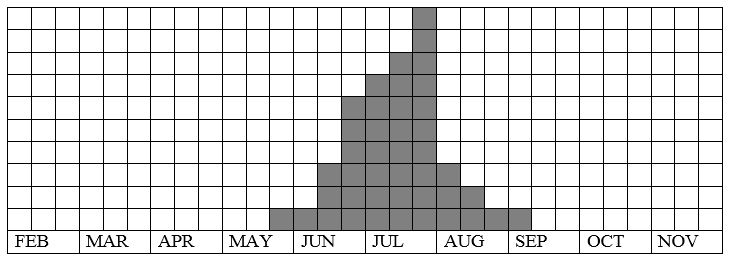
Fig. 105-2. Melitaea didyma, habitat characteristics of the Spotted fritillary.
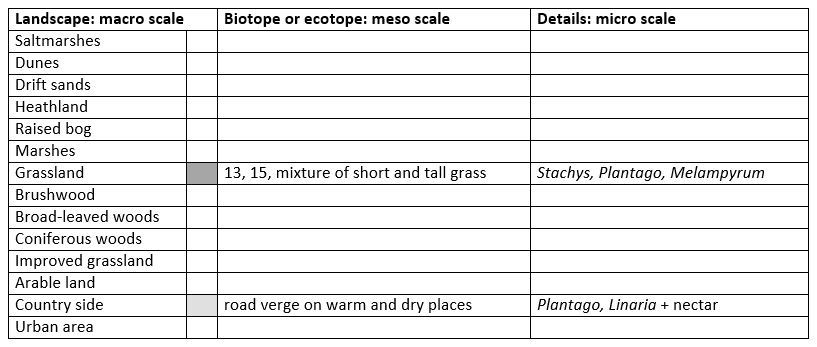
Fig. 105-3. Melitaea didyma, climate matrix, heat-sums 900 - 3000°d.

|











